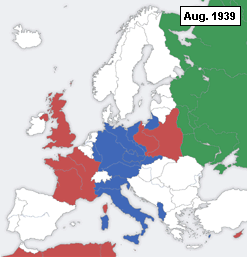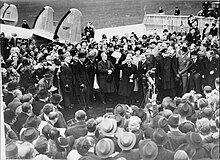
The Tripartite Pact, also known as the Berlin Pact, was an agreement between Germany, Italy, and Japan signed in Berlin on 27 September 1940 by, respectively, Joachim von Ribbentrop, Galeazzo Ciano, and Saburō Kurusu and in the presence of Adolf Hitler. It was a defensive military alliance that was eventually joined by Hungary, Romania, Bulgaria, and Yugoslavia as well as by the German client state of Slovakia. Yugoslavia's accession provoked a coup d'état in Belgrade two days later. Germany, Italy, and Hungary responded by invading Yugoslavia. The resulting Italo-German client state, known as the Independent State of Croatia, joined the pact on 15 June 1941.

A declaration of war is a formal act by which one state announces existing or impending war activity against another. The declaration is a performative speech act by an authorized party of a national government, in order to create a state of war between two or more states.

The causes of World War II have been given considerable attention by historians. The immediate precipitating event was the invasion of Poland by Nazi Germany on September 1, 1939, and the subsequent declarations of war on Germany made by Britain and France, but many other prior events have been suggested as ultimate causes. Primary themes in historical analysis of the war's origins include the political takeover of Germany in 1933 by Adolf Hitler and the Nazi Party; Japanese militarism against China, which led to the Japanese invasion of Manchuria and the Second Sino-Japanese War; Italian aggression against Ethiopia, which led to the Second Italo-Ethiopian War; the consent of Western countries to Germany's actions on the annexation of Austria and the partition of Czechoslovakia; and Germany's initial success in negotiating the Molotov–Ribbentrop Pact with the Soviet Union to divide the territorial control of Eastern Europe between them.

Józef Beck was a Polish statesman who served the Second Republic of Poland as a diplomat and military officer. A close associate of Józef Piłsudski, Beck is most famous for being Polish foreign minister in the 1930s and for largely setting Polish foreign policy.

This timeline of events preceding World War II covers the events that affected or led to World War II.

The Allies, formally referred to as the United Nations from 1942, were an international military coalition formed during World War II (1939–1945) to oppose the Axis powers. Its principal members by the end of 1941 were the "Big Four" – United Kingdom, United States, Soviet Union, and China.
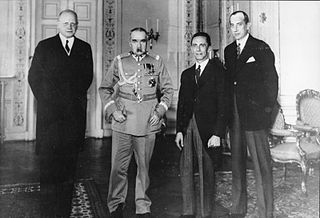
The German–Polish declaration of non-aggression, also known as the German–Polish non-aggression pact, was an agreement between Nazi Germany and the Second Polish Republic that was signed on 26 January 1934 in Berlin. Both countries pledged to resolve their problems by bilateral negotiations and to forgo armed conflict for a period of 10 years. The agreement effectively normalised relations between Poland and Germany, which had been strained by border disputes arising from the territorial settlement in the Treaty of Versailles. The declaration marked an end to an economically damaging customs war between the two countries that had taken place over the previous decade.
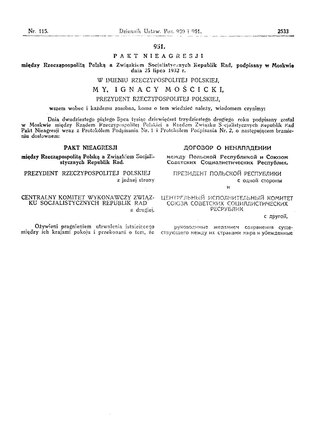
The Soviet–Polish Non-Aggression Pact was a non-aggression pact signed in 1932 by representatives of Poland and the Soviet Union. The pact was unilaterally broken by the Soviet Union on September 17, 1939, during the Soviet invasion of Poland.
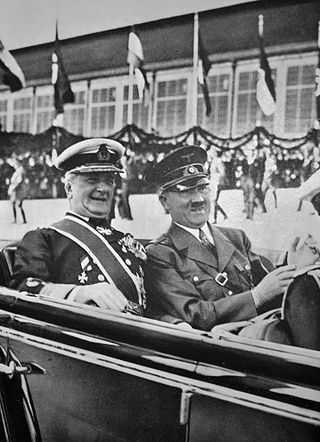
During World War II, the Kingdom of Hungary was a member of the Axis powers. In the 1930s, the Kingdom of Hungary relied on increased trade with Fascist Italy and Nazi Germany to pull itself out of the Great Depression. Hungarian politics and foreign policy had become more stridently nationalistic by 1938, and Hungary adopted an irredentist policy similar to Germany's, attempting to incorporate ethnic Hungarian areas in neighboring countries into Hungary. Hungary benefited territorially from its relationship with the Axis. Settlements were negotiated regarding territorial disputes with the Czechoslovak Republic, the Slovak Republic, and the Kingdom of Romania. On November 20, 1940, Hungary became the fourth member to join the Axis powers when it signed the Tripartite Pact. The following year, Hungarian forces participated in the invasion of Yugoslavia and the invasion of the Soviet Union. Their participation was noted by German observers for its particular cruelty, with occupied peoples subjected to arbitrary violence. Hungarian volunteers were sometimes referred to as engaging in "murder tourism."

The Anglo-Soviet Agreement was a declaration signed by the United Kingdom and the Soviet Union on 12 July 1941 to cooperate in the war against Nazi Germany. Shortly after the beginning of Operation Barbarossa, the German invasion of the Soviet Union, both powers pledged to assist each other and not to make a separate peace with Germany.

Relevant events began regarding the Baltic states and the Soviet Union when, following Bolshevist Russia's conflict with the Baltic states—Lithuania, Latvia and Estonia—several peace treaties were signed with Russia and its successor, the Soviet Union. In the late 1920s and early 1930s, the Soviet Union and all three Baltic States further signed non-aggression treaties. The Soviet Union also confirmed that it would adhere to the Kellogg–Briand Pact with regard to its neighbors, including Estonia and Latvia, and entered into a convention defining "aggression" that included all three Baltic countries.
The timeline of the Molotov–Ribbentrop Pact is a chronology of events, including Molotov–Ribbentrop Pact negotiations, leading up to, culminating in, and resulting from the Molotov–Ribbentrop Pact. The Treaty of Non-aggression between Nazi Germany and the Soviet Union was signed in the early hours of 24 August 1939, but was dated 23 August.

The European foreign policy of the Chamberlain ministry from 1937 to 1940 was based on British Prime Minister Neville Chamberlain's commitment to "peace for our time" by pursuing a policy of appeasement and containment towards Nazi Germany and by increasing the strength of Britain's armed forces until, in September 1939, he delivered an ultimatum over the invasion of Poland, which was followed by a declaration of war against Germany.

On December 8, 1941, at 12:30 PM ET the United States Congress declared war, on the Empire of Japan in response to its surprise attack on Pearl Harbor and subsequent declaration of war the prior day. The Joint Resolution Declaring that a state of war exists between the Imperial Government of Japan and the Government and the people of the United States and making provisions to prosecute the same was formulated an hour after the Infamy Speech of President Franklin D. Roosevelt. Following the U.S. declaration, Japan's allies, Germany and Italy, declared war on the United States, bringing the United States fully into World War II. The Japanese government had originally intended to deliver their own declaration of war thirty minutes before the attack, but the Japanese embassy in Washington took too long to decode the 5,000-word document.
A declaration of war by Canada is a formal declaration issued by the Government of Canada indicating that a state of war exists between Canada and another nation. It is an exercise of the royal prerogative on the constitutional advice of the ministers of the Crown in Cabinet and does not require the direct approval of the Parliament of Canada, though such can be sought by the government. Since gaining the authority to declare war as a consequence of the Statute of Westminster, 1931, Canada has done so only during the Second World War.

The United Kingdom declared war on Germany on Sunday 3 September 1939, two days after Germany invaded Poland. France also declared war on Germany later the same day.
A declaration of war is a formal act by which one nation goes to war against another. A declaration is usually an act of delivering a performative speech or the presentation of a signed document by an authorized party of a national government in order to create a state of war between two or more sovereign states. In the context of World War I, the official international protocol for declaring war was defined in the Hague Convention of 1907. For the diplomatic maneuvering behind these events, which led to hostilities between nations, see Diplomatic history of World War I.

On 3 September 1939—two days after the German invasion of Poland—France declared war on Nazi Germany according to its defensive treaty with Poland, when France's ultimatum to Germany, issued the previous day, expired at 17:00. This occurred hours after the United Kingdom declaration of war on Germany.
The Declaration of St James's Palace, or London Declaration, was the first joint statement of goals and principles by the Allied Powers during World War II. The declaration was issued after the first Inter-Allied Conference at St James's Palace in London on 12 June 1941. Representatives of the United Kingdom, the four co-belligerent Commonwealth Dominions, the eight governments in exile and Free France were parties to the declaration. It stated the Allies' commitment to continue the war against the Axis Powers and established principles to serve as the basis of a future peace.

The Battle of Alsónyárasd, took place between 20 and 21 June 1849, in Alsónyárasd, as part of the Battle of Pered of the Summer Campaign of Hungarian War of Independence.
